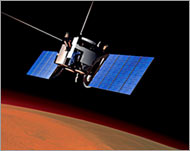Third day of silence from Mars
Scientists anxiously awaited a sign on Sunday that Europe’s first Mars probe had landed safely on the Red Planet.

For the third night running, the giant Lovell telescope at Jodrell Bank in northwest England failed to pick up a signal from Beagle 2 which has also failed three times to communicate a message to NASA’s Mars Odyssey orbiter.
After three nights of fruitless sweeping for a radio signal, scientists in Britain remained optimistic, but conceded it was now probably up to the European Space Agency’s (ESA’s) Mars orbiter to track down the silent probe.
While the fate of the so-called “lander” remains unknown almost 72 hours after it headed for the Martian surface after piggy-backing a ride on the Mars Express, its creators have refused to give up hope.
“We’re going to keep going until every possibility has been exhausted,” said Alan Wells, a member of the team at Britain’s National Space Centre.
|
“We’re going to keep going until every possibility has been exhausted” Alan Wells, |
Beagle 2’s lead scientist and the man largely responsible for the project, Professor Colin Pillinger, told a Saturday news conference the Mars Express now provided the best chance of contacting the probe.
“Mars Express is our primary route of communication. It’s the one we spent most of our time over the last five years testing,” said Pillinger.
“We need to get Beagle 2 into a period when it can broadcast for a much longer period.”
“This will happen around January 4 after the spacecraft has experienced a sufficient number of communication failures to switch to automatic transmission mode,” he said.
By then, the Mars Express will hopefully have completed a series of final orbital manoeuvres, leaving it in position to receive, fingers-crossed, the Beagle 2’s signal – a nine-note tune composed by the British pop group Blur.
Frustrating wait
“At the moment, I am frustrated rather than concerned,” Pillinger added.
The Lovell telescope and NASA’s craft will meanwhile continue
their daily sweeps, as well as a further telescope based at Stanford University in California.
Although Beagle 2 is one of the most spectacular parts of the mission, it represents only about 10 % of the total scientific work aboard the Mars Express, European Space Agency scientists have stressed.
Other instruments aboard the Mars Express will enable researchers to obtain the most comprehensive coverage of the planet to date, mission directors have said.
The instruments include a stereoscopic camera, a means of
observing gravity anomalies, a radar capable of seeing beneath the surface and spectrometers to examine minerals and the atmosphere for any evidence of life.
 |
|
Beagle 2 is only about 10 % of |
The 33kg Beagle 2 detached from Mars Express on 19 December and started a gliding descent towards the planet surface to begin its mission to search for signs of life.
Packed with revolutionary instruments, the disc-shaped probe had been due to touch down at Isidis Planitia, a large, flat plain near the Martian equator that may once have been awash with water.
The landing, by far the trickiest challenge in Beagle 2’s
400-million-kilometre trek, began with re-entry 120 kilometres above Mars when the probe was to meet the first molecules of the planet’s mainly carbon-dioxide atmosphere at 20,000
kph.
The last phase was the inflation of airbags that were to swathe the lander like protective beachballs so it could bounce to an eventual standstill on the planet’s surface.
After that, the lander had to open up and let its solar panels
open out like petals, getting light from the distant sun to recharge its batteries.
Cause of failure
According to the mission’s website, one possible cause of the
communication failure is that the clock on Beagle 2 may have been reset as the result of a computer glitch.
Specialists continue to investigate other potential reasons for the failure, including a possible landing off course, a tilting of the spacecraft and a problem in fully opening the solar panels.
The next opportunity for the Beagle 2 to call home will be during a sweep by NASA’s Mars Odyssey beginning at 18:57 GMT on Sunday.